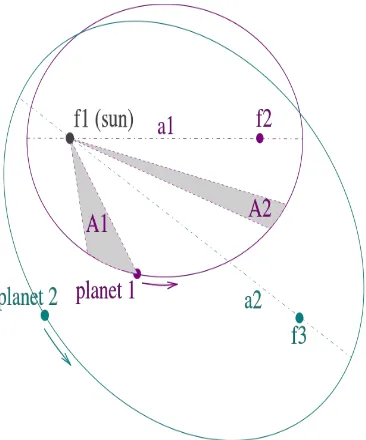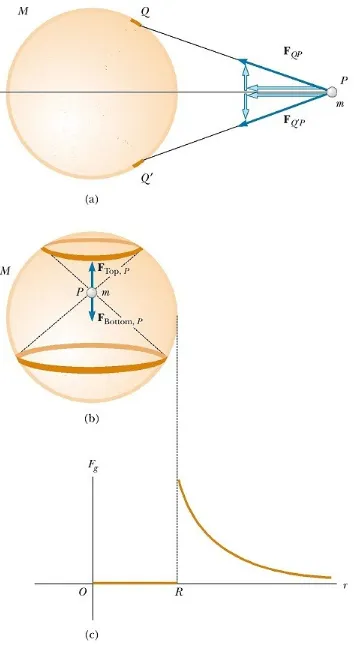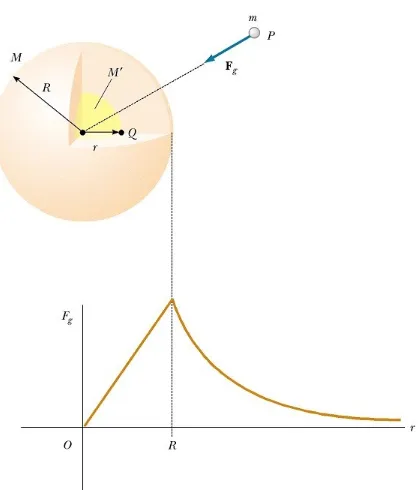Hukum Newton tentang gaya tarik menarik gravitasi umum
Hukum tarik-menarik gravitasi Newton dalam bidang fisika berarti gaya tarik untuk saling mendekat satu sama lain. Dalam bidang fisika tiap benda dengan massa m1 selalu mempunyai gaya tarik menarik dengan benda lain (dengan massa m2 ). Misalnya partikel satu dengan partikel lain selalu akan saling tarik-menarik. Contoh yang dikemukakan oleh Sir Isaac Newton dalam bidang mekanika klasik bahwa benda apapun di atas atmosfer akan ditarik oleh bumi, yang kemudian banyak dikenal sebagai fenomena benda jatuh.
Gaya tarik menarik gravitasi ini dinyatakan oleh Isaac Newton melalui tulisannya di journal Philosophiæ Naturalis Principia Mathematica pada tanggal 5 Juli 1687 dalam bentuk rumus sebagai berikut:
, di mana:
F adalah besarnya gaya gravitasi antara dua massa tersebut,
G adalah konstante gravitasi,
m1 adalah massa dari benda pertama
m2 adalah massa dari benda kedua, dan
r adalah jarak antara dua massa tersebut.
Teori ini kemudian dikembangkan lebih jauh lagi bahwa setiap benda angkasa akan saling tarik-menarik, dan ini bisa dijelaskan mengapa bumi harus berputar mengelilingi matahari untuk mengimbangi gaya tarik-menarik gravitasi bumi-matahari. Dengan menggunakan fenomena tarik menarik gravitasi ini juga, meteor yang mendekat ke bumi dalam
perjalanannya di ruang angkasa akan tertarik jatuh ke bumi.
Setiap planet bergerak dengan lintasan elips, Matahari berada di salah satu fokusnya.
Luas daerah yang disapu pada selang waktu yang sama akan selalu sama.
Perioda kuadrat suatu planet berbanding dengan pangkat tiga jarak rata-ratanya dari Matahari.
Ketiga hukum di atas ditemukan oleh ahli matematika dan astronomi Jerman: Johannes Kepler (1571–1630), yang menjelaskan gerakan planet di dalam tata surya. Hukum di atas menjabarkan gerakan dua benda yang saling mengorbit.
Karya Kepler didasari oleh data pengamatan Tycho Brahe, yang diterbitkannya sebagai 'Rudolphine tables'. Sekitar tahun 1605, Kepler menyimpulkan bahwa data posisi planet hasil pengamatan Brahe mengikuti rumusan matematika cukup sederhana yang tercantum di atas. Hukum Kepler mempertanyakan kebenaran astronomi dan fisika warisan zaman Aristoteles dan Ptolemaeus. Ungkapan Kepler bahwa Bumi beredar sekeliling, berbentuk elips dan bukannya epicycle, dan membuktikan bahwa kecepatan gerak planet bervariasi, mengubah astronomi dan fisika. Hampir seabad kemudian, Isaac Newton mendeduksi Hukum Kepler dari rumusan hukum karyanya, hukum gerak dan hukum gravitasi Newton, dengan
menggunakan Euclidean geometri klasik.
Pada era modern, hukum Kepler digunakan untuk aproksimasi orbit satelit dan benda-benda yang mengorbit Matahari, yang semuanya belum ditemukan pada saat Kepler hidup (contoh: planet luar dan asteroid). Hukum ini kemudian diaplikasikan untuk semua benda kecil yang mengorbit benda lain yang jauh lebih besar, walaupun beberapa aspek seperti gesekan atmosfer (contoh: gerakan di orbit rendah), atau relativitas (contoh: prosesi preihelion merkurius), dan keberadaan benda lainnya dapat membuat hasil hitungan tidak akurat dalam berbagai keperluan.
the same surface area and the time for planet 1 to cover segment A1 is equal to the time to cover segment A2. (3) The total orbit times for planet 1 and planet 2 have a ratio a13/2 : a23/2.
Gerak harmonik sederhana adalah gerak bolak – balik benda melalui suatu titik
keseimbangan tertentu dengan banyaknya getaran benda dalam setiap sekon selalu konstan Periode (T) adalah waktu yang diperlukan benda untuk melakukan satu getaran. Satuan periode detik
Frekuensi (f) adalah banyaknya getaran yang dilakukan oleh benda selama satu detik. Satuan frekuensi hertz
Hubungan antara periode dan frekuensi :
atau
Hukum Hooke menyatatakan bahwa besar gaya pegas pemulih sebanding dengan pertambahan panjang pegas. Secara matematis, dapat dituliskan sebagai :
F = – k Δx
dengan k = tetapan pegas (N/m)
Tanda (-) diberikan karena arah gaya pemulih pada pegas berlawanan dengan arah gerak pegas tersebut.
Persamaan Gerak Harmonik Sederhana Y = A sin ωt
di mana : Y = simpangan
A = simpangan maksimum (amplitudo)
ω = kecepatan sudut = 2πf
t = waktu
Kecepatan maksimumnya adalah vmax = A ω
Energi pada Gerak Harmonik Sederhana adalah E = ½ kA2
Hukum Kepler I, II dan III
1. Hukum I Kepler
Menjelaskan tentang bentuk lingkaran orbit planet. Bunyi hukum Keppler 1 berisi sebagai berikut.
Lintasan setiap planet mengelilingi matahari merupakan sebuah elips dengan matahari terletak pada salah satu titik fokusnya.
Nah setelah melihat hukum pertama Kepler dapat dilihat ilustrasi tersebut seperti pada Gambar berikut ini.
2. Hukum II Kepler
Menjelaskan tentang kecepatan orbit planet. Apa perbedaan dengan hukum kepler pertama? Perhatikan penjelasan berikut, hukum Keppler 2 berisi sebagai berikut Setiap planet bergerak sedemikian sehingga suatu garis khayal yang ditarik dari matahari ke planet tersebut mencakup daerah dengan luas yang sama dalam waktu yang sama.
Untuk lebih jelasnya silahkan amati gambar berikut
Ilustrasi orbit planet sesuai hukum ketiga Kepler
Keterangan :
Garis AM akan menyapu lurus sampai ke garis BM, luasnya sama dengan daerah yang disapu garis Cm hingga DM. Jika tAB = tCD. Hukum kedua ini juga
menjelaskan bahwa dititik A dan B planet harus lebih cepat dibanding saat di titik C dan D.
3. Hukum III Kepler
Menjelaskan tentang periode revolusi planet. Periode revolusi planet ini dikaitkan dengan jari-jari orbit rata-ratanya. Perhatikan penjelasan berikut, hukum Keppler 3 berisi sebagai berikut
Kuadrat periode planet mengitari matahari sebanding dengan pangkat tiga rata-rata planet dari matahari.
THE GRAVITATIONAL FORCE BETWEEN A PARTICLE AND A SPHERICAL MASS We have already stated that a large sphere attracts a particle outside it as if the total mass of the sphere were concentrated at its center. We now describe the force acting on a particle when the extended object is either a spherical shell or a solid sphere, and then apply these facts to some interesting systems.
Spherical Shell
Case 1. If a particle of mass m is located outside a spherical shell of mass M at, for instance, point P in Figure 14.21a, the shell attracts the particle as though the mass of the shell were concentrated at its center. We can show this, as Newton did, with integral calculus. Thus, as far as the gravitational force acting on a particle outside the shell is concerned, a spherical shell acts no differently from the solid spherical distributions of mass we have seen.
Case 2. If the particle is located inside the shell (at point P in Fig. 14.21b), the gravitational force acting on it can be shown to be zero.
We can express these two important results in the following way:
ring, the bottom ring is larger, and the gravitational forces exerted on the particle at P by the matter in the two rings cancel each other. Thus, for a particle located at any point P inside the shell, there is no gravitational force exerted on the particle by the mass M of the shell. (c) The magnitude of the gravitational force versus the radial distance r from the center of the shell. The shell does not act as a gravitational shield, which means that a particle inside a shell may experience forces exerted by bodies outside the shell.
Solid Sphere
Case 1. If a particle of mass m is located outside a homogeneous solid sphere of mass M (at point P in Fig. 14.22), the sphere attracts the particle as though the mass of the sphere were concentrated at its center. We have used this notion at several places in this chapter already, and we can argue it from Equation 14.25a. A solid sphere can be considered to be a collection of concentric spherical shells. The masses of all of the shells can be interpreted as being concentrated at their common center, and the gravitational force is equivalent to that due to a particle of mass M located at that center.
Case 2. If a particle of mass m is located inside a homogeneous solid sphere of mass M (at point Q in Fig. 14.22), the gravitational force acting on it is due only to the mass M’ contained within the sphere of radius shown in Figure 14.22. In other words,
Figure 14.22 The gravitational force acting on a particle when it is outside a uniform solid sphere is GMm/r2 and is directed toward the center of the sphere. The gravitational force acting on the particle when it is inside such a sphere is proportional to r and goes to zero at the center.
Solving this equation for M’ and substituting the value obtained into Equation 14.26b, we have
This equation tells us that at the center of the solid sphere, where r = 0, the gravitational force goes to zero, as we intuitively expect. The force as a function of r is plotted in Figure 14.22. Case 3. If a particle is located inside a solid sphere having a density ρ that is spherically symmetric but not uniform, then M’ in Equation 14.26b is given by an integral of the form M’ = ∫ρ dV, where the integration is taken over the volume contained within the sphere of radius r in Figure 14.22. We can evaluate this integral if the radial variation of ρ is given. In this case, we take the volume element dV as the volume of a spherical shell of radius r and thickness dr, and thus dV = 4πr2 dr. For example, if ρ = Ar, where A is a constant, it is left to a problem (Problem 63)
Areal velocity
From Wikipedia, the free encyclopedia
Areal velocity is the area (shown in green) swept out per unit time by a particle moving along a curve (shown in blue).
suppose that a particle moves along the blue curve. At a certain time t, the particle is located at point B, and a short while later, at time t + Δt, the particle has moved to point C. The area swept out by the particle is the green area in the figure, bounded by the line segments AB and AC and the curve along which the particle moves. The areal velocity equals this area divided by the time interval Δt in the limit that Δt becomes vanishingly small.
Illustration of Kepler's second law. The planet moves faster near the Sun, so the same area is swept out in a given time as at larger distances, where the planet moves more slowly.
The concept of areal velocity is closely linked historically with the concept of angular momentum. Kepler's second law states that the areal velocity of a planet, with the sun taken as origin, is constant. Isaac Newton was the first scientist to recognize the dynamical significance of Kepler's second law. With the aid of his laws of motion, he proved in 1684 that any planet that is attracted to a fixed center sweeps out equal areas in equal intervals of time. By the middle of the 18th century, the principle of angular momentum was discovered gradually by Daniel Bernoulli and Leonhard Euler and Patrick d'Arcy; d'Arcy's version of the principle was phrased in terms of swept area. For this reason, the principle of angular
momentum was often referred to in the older literature in mechanics as "the principle of areas." Since the concept of angular momentum includes more than just geometry, the designation "principle of areas" has been dropped in modern works.
Connection with angular momentum
In the situation of the first figure, the area swept out during time period Δt by the particle is approximately equal to the area of triangle ABC. As Δt approaches zero this near-equality becomes exact as a limit.
Let the point D be the fourth corner of parallelogram ABDC shown in the figure, so that the vectors AB and AC add up by the parallelogram rule to vector AD. Then the area of triangle ABC is half the area of parallelogram ABDC, and the area of ABDC is equal to the magnitude of the cross product of vectors AB and AC. This area can also be viewed as a vector with this magnitude, pointing in a direction perpendicular to the parallelogram; this vector is the cross product itself:
Hence
The areal velocity is this area divided by Δt in the limit that Δt becomes vanishingly small: But, is the velocity vector of the moving particle, so that
and hence the angular momentum equals 2m times the areal velocity.
Conservation of areal velocity is a general property of central force motion.[1]
The Universal Law of Gravitation
Gravity is described from the point of view of a universal law. This implies that gravity is a force that should behave in similar ways regardless of where you are in the universe.
Gravity
It's a force of attraction that exists between any two objects that have mass. The more mass they have, the greater the force of attraction. The closer they are, the greater the force of attraction.
For most objects you get near every day, the force of attraction is so incredibly small that you would never notice the force. Gravity is a very weak force, so between common objects like you and your pencil, the force of attraction is very small because your mass and the mass of your pencil are small. We only get noticeable amounts of gravity when at least one object is very massive... like a planet. The force of attraction between you and the planet Earth is a noticeable force! We call the force of attraction between you and the Earth, your weight. Weight is another name for the force of gravity pulling down on you or anything else.
G
is the universal gravitational constant. It is basically a conversion factor to adjust the number and units so they come out to the correct value. This is a universal constant so it is truem
1 is the mass of one of the objects.m
2 is the mass of the other object.r
is the radius of separation between the center of masses of each object.F
G is the force of attraction between the twoobjects.
Important Concepts
The direction of the force is not given by this formula since there are actually two forces equal in size but opposite in direction. This formula calculates them both.
The formula is an inverse square law for radius of separation (notice the
r
2 on the bottom of the equation). This means that if you double the separation you quarter the force, or if you cut the separation in half you quadruple the force of attraction.If you double a single mass, you double the force. If you cut one of the masses in half, you cut the force in half. But if you double both masses you would quadruple the force.
Common Misconceptions
"There is no gravity in space." FALSE If there were no gravity in space, the space shuttle would not be able to orbit the Earth, the moon would not orbit the Earth, and the Earth would not orbit the Sun. The reason we tend to think of there being no gravity in space is that we have seen movies of the astronauts being "weightless". They aren't actually weightless, they are still being pulled down by gravity but they and the space shuttle are in a constant state of freefall around the Earth. So they seem to be weightless as a result of the falling - just as you would seem weightless if you were in an elevator when the cable broke.
"G and g are the same thing." FALSE Big G is the universal gravitational constant. Little g is the acceleration due to the force of gravity and its value of 9.8m/s/s down is only true on this planet. It is not a universal constant.
"g is gravity." FALSE Little g is the effect of the force of gravity, but is not gravity. Gravity is a force, little g is an acceleration caused by gravity.


